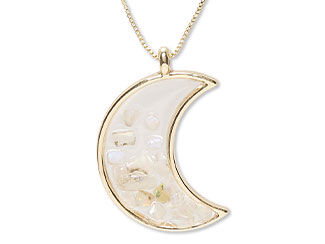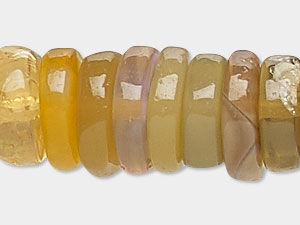Opal, Ethiopian Meaning and Properties
Ethiopian Opal History
Discovered in 1990, Ethiopian opal was first commercially mined in 2008. It comes from Ethiopia's northern Welo (or Wello) District. A range of deposits in the area offer several opal types, including those found at Australia’s Coober Pedy mines!
In 1929, anthropologists ascertained some evidence of opal in caves of Kenya, with some pieces being used for tools.
"Opal" comes from the Sanskrit word उपल (upala), which means "precious stone." This comes from the stories from ancient India, which said the Mother Goddess changed the virgin Goddess of the Rainbow into a stone to save her from the amorous attentions of three gods. The word was adopted in Latin during Roman times as opalus.
Opal is one of the official birthstones for the month of October (along with pink tourmaline) and an alternative birthstone for April. It is modernly used to mark the 14th anniversary of a marriage.
To learn more about the different kinds of opal, view our opal meaning and properties article.
What are the Metaphysical Properties of Ethiopian Opal?
The ancient Greeks thought the stone could give people the gift of prophecy and protect them from disease. Some metaphysical thought includes the idea that wearing opal can make you unobtrusive or unnoticeable, pulling all of a person’s human sparkle into the fiery colors of the stone. While some people believe it is unlucky for people not born in October to wear opal, the gemstone has actually long been valued as a stone of luck and magic—as well as love and passion.
Ethiopian opal meaning is linked to love. This stone is believed to be an emotional intensifier, enhancing the true nature of those who wear it. Some say it strengthens the will to live and shields the wearer against negativity, burning off karma. Practitioners of energy work say Ethiopian opal meaning is affiliated with the base and sacral chakras , although other base colors of this opal can be used with corresponding chakras if needed.
What is Ethiopian Opal Made From?
Most opals are sedimentary in nature--that is, they are created from the layers laid down by ancient waterways. Ethiopian opals, however, are hydrophane opals, created as a result of volcanic activity, forming in nodules within the volcanic ash in stratum between rhyolite layers.
"Hydrophane" comes from the Greek words meaning "water-loving," and describes how these opals tend to absorb water. Water absorption can alter the appearance of Ethiopian opal, changing the stone from opaque or semi-translucent to highly translucent and almost transparent.
The high cost and fragility of sedimentary opals mean the stone is rarely faceted. The significantly lower price and tougher structure of hydrophane Ethiopian opal rough has made it more likely for gem-cutters to experiment with faceting and carving the stone.
- Mineral Information: Hardened silica gel with water content
- Chemical Composition: SiO2-nH2O
- Color: Colorless, white, yellow, red, orange, green, brown, black, blue to waxy
- Hardness: 5-1/2 to 6 (Mohs)
- Specific Gravity: 1.98 - 2.20
- Refractive Index: 1.450
How Do You Clean Ethiopian Opal?
Opal is a soft, porous stone that is sensitive to environmental factors such as heat and moisture. While Ethiopian opal is slightly more durable to sudden surface shocks (accidental bumps), the gem is still vulnerable. Never run an opal—even an Ethiopian opal—through a steamer or ultrasonic cleaner.
Don’t wear your opals in the shower, while swimming, using cleaning agents, applying perfume, using a hair dryer or other temperature and chemical exposures.
Ethiopian Opal FAQ
Q: What makes Ethiopian opal different from Australian opal?
A: Besides the obvious difference in sourcing, Ethiopian opal’s main geological difference is that it is hydrophane opal, subject to changes in opacity, color and even size.
Q: Why are some Ethiopian opal beads so pale?
A: In general, opals can be a variety of colors, and Ethiopian opals are no different. There are several types of Ethiopian opals. Mezezo opals tend to be paler, with a consistent pattern. Welo opals are vibrant, with higher transparency. Shewa opals have mottled patterns in earthy, organic hues.
Q: Are Ethiopian opals hydrophanes?
A: Ethiopian opals are hydrophanes, formed as nodules within volcanic ash, and subject to changes in opacity when hydrated.
Q: Can Ethiopian opal be used for a birthstone?
A: Opal is the official birthstone for October, and as part of that category, Ethiopian opal can be used as a birthstone.
Designing with Ethiopian Opal
Ethiopian opal, with its milky white to light amber base coloring, can be treated as a white or golden stone when using color theory design ideas. The play of colors that makes opal famous and popular allows it to be included in a range of places. The faceted styles of Ethiopian opal beads offer options that use both the fiery color play and a subtle sparkle.
With opal’s known fragility, even the tougher hydrophane opal needs to be treated with care. It is ideally suited for necklaces, earrings or pendants rather than anklets, bracelets or rings that could experience impacts and scratches.
A Design Inspiration to Get You Started
Shop for Ethiopian Opal
**Please note that all metaphysical or healing properties listed are collected from various sources. This information is offered as a service and not meant to treat medical conditions. Fire Mountain Gems and Beads® does not guarantee the validity of any of these statements.
How did you like this resource? Your feedback helps us provide resources that matter to you most.
Copyright Permissions
All works of authorship (articles, videos, tutorials and other creative works) are from the Fire Mountain Gems and Beads® Collection, and permission to copy is granted for non-commercial educational purposes only. All other reproduction requires written permission. For more information, please email copyrightpermission@firemtn.com.


